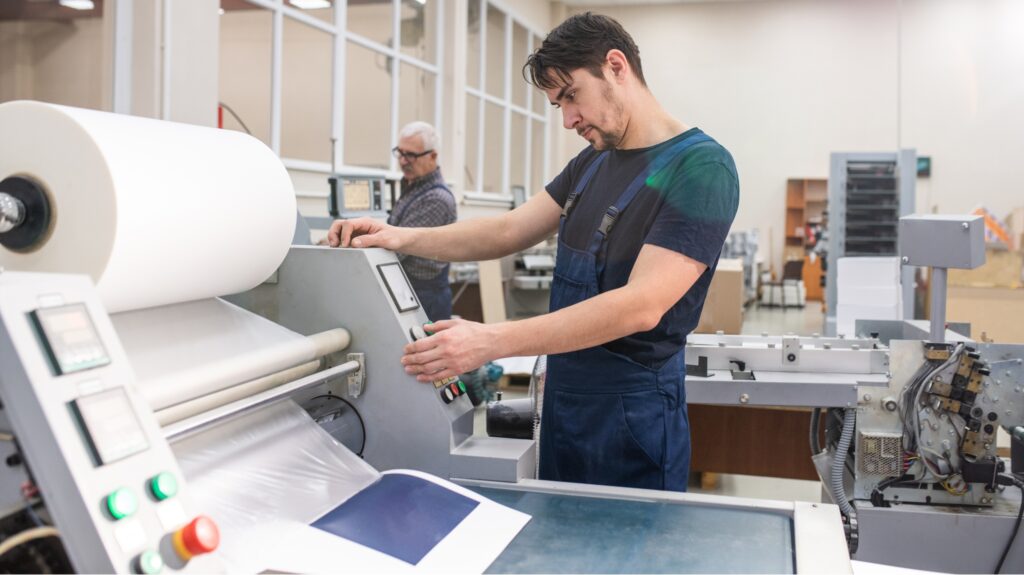Printing Equipment Essentials: Navigating the World of Printing
This post was last updated on March 22nd, 2024
Printing has become an integral aspect of modern society, with many industries relying heavily on this sophisticated technology.
From graphic design studios to newspaper publishers and marketing agencies, the demand for high-quality printing continues to rise. However, navigating the world of printing equipment can often take time due to the many options available in today’s market.
This article outlines the essential aspects one must consider when delving into printing equipment to alleviate these concerns and empower businesses with knowledge.
By providing comprehensive guidance and expert insights, readers will gain an understanding of everything they need to know before making any substantial investment in their printing infrastructure.

A Comprehensive Guide to Different Printing Equipment Types
Printing has evolved significantly over the years, and a wide array of printing equipment types came with it. Understanding these different types is essential for businesses investing in new printing technology or upgrading their current setup. This comprehensive guide aims to simplify the process by providing an overview of the most common printing equipment types available today.
One crucial aspect to consider when navigating the world of printing equipment is the distinction between digital and offset printers. Digital printers are best suited for short-run printing projects that require quick turnaround times and variable data capabilities. On the other hand, offset printers excel in handling large volumes of prints while maintaining consistent quality. Both types have their merits, so understanding your needs and budget constraints is key in choosing the right option.
Another essential consideration is whether to opt for inkjet or laser printers. Inkjet printers spray liquid ink onto paper, making them ideal for vibrant colours and detailed images. Laser printers rely on toner cartridges and heat to fuse ink onto paper, providing exceptional speed without compromising quality. Deciding between these technologies depends on the desired print resolution, cost per page, and expected print volume.
Maximizing Printing Efficiency with Quality Equipment
Printing efficiency is crucial for businesses that heavily rely on printing technology. Maximizing printing efficiency saves time, reduces costs, and improves productivity. One of the key factors in achieving this objective is investing in quality equipment.
Quality printing equipment ensures reliable performance, durability, and consistent results. It minimizes downtime due to technical issues or malfunctions, allowing businesses to efficiently meet deadlines and fulfil customer expectations. High-quality printers also offer advanced features such as fast print speeds, high-resolution output, and versatile paper handling capabilities.
Using quality equipment helps businesses streamline their printing processes. Advanced features like automatic duplexing (double-sided printing), built-in Wi-Fi connectivity for wireless printing, and software integration simplify operations and enhance overall efficiency. Businesses can optimize their printing workflows and achieve maximum output by choosing top-notch equipment from reputable manufacturers while maintaining high-quality standards.
Investing in quality equipment is essential when it comes to maximizing printing efficiency. Such devices provide dependable performance, advanced features, and streamlined workflows that improve productivity and cost-effectiveness.
Innovations and Trends in the Printing Equipment Industry
The constant demand for improved quality, efficiency, and versatility drives innovations and trends in the printing equipment industry. One major trend is the shift towards digital printing technology. Digital printers offer faster turnaround times, variable data capability, and high-quality output that rivals traditional offset printing. In addition, advancements in inkjet technology have allowed for greater colour accuracy and expanded substrate compatibility.
Another innovation in the printing equipment industry is the integration of automation and artificial intelligence (AI). Printers are now equipped with advanced software that automates printing, such as file preparation, colour management, job scheduling, and finishing options. AI-powered systems can analyze print jobs in real-time to optimize production workflows and minimize waste.
Furthermore, sustainability has emerged as a key factor driving innovations in the printing equipment industry. Manufacturers are now focusing on developing eco-friendly technologies such as energy-efficient printers, recyclable materials for ink cartridges or toner cartridges, and water-based or soy-based inks with lower environmental impacts than traditional petroleum-based ones.
These innovations and trends aim to provide businesses with efficient, versatile, and environmentally friendly solutions that meet their diverse printing needs while keeping up with ever-evolving market demands.
You may like this
Recommended For You
3 Key Leadership Skills for Business Owners
Most Inside
Most Inside offers high-quality recommendations and valuable updates to enhance all aspects of your life, providing premium guidance and enriching experiences.




